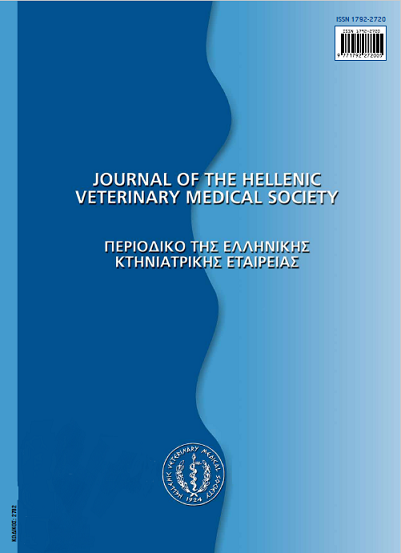Επίδραση επικάλυψης χιτοζάνης στο χρόνο ζωής προψημένων βόειων κεφτέδων και τον έλεγχο της ανάπτυξης της Listeria monocytogenes στην επιφάνεια τους κατά τη διάρκεια συντήρησής τους υπό ψύξη

Περίληψη
Η επίδραση εδώδιμων μεμβρανών χιτοζάνης στην επιφάνεια προψημένων (RTE) βόειων κεφτέδων αξιολογήθηκε ως προς το χρόνο ζωής τους και τον έλεγχο της ανάπτυξης της Listeria monocytogenes στους 5 °C. L. monocytogenes ενοφθαλμίστηκε στην επιφάνεια προψημένων βόειων κεφτέδων με ή χωρίς επικάλυψη χιτοζάνης. Τα δείγματα αποθηκεύτηκαν στους 5 °C και τις ημέρες 0,1,7,14,21 και 28 καταμετρήθηκαν οι μεταβολές των πληθυσμών των ολικών αερόβιων βακτηρίων, της L. monocytogenes, των οξυγαλακτικών βακτηρίων και των εντεροβακτηρίων. Τα οργανοληπτικά χαρακτηριστικά των δειγμάτων αξιολογήθηκαν τις ίδιες ημέρες από ομάδα ημιεκπαιδευμένων κριτών. Η ανάλυση των αποτελεσμάτων έδειξε ότι η χρήση εδώδιμων μεμβρανών χιτοζάνης μείωσε όλους τους μικροβιακούς πληθυσμούς που καταμετρήθηκαν και καθυστέρησε την ανάπτυξή τους οδηγώντας στο συμπέρασμα ότι μπορεί να επιμηκύνει το χρόνο ζωής των προϊόντων αυτών κατά 14 ημέρες. Επιπλέον, οι πληθυσμοί της L. Monocytogenes ήταν περίπου κατά 2 log CFU/g μικρότεροι στους καλυμμένους με χιτοζάνη κεφτέδες. Συνεπώς, η χρήση χιτοζάνης είχε ανασταλτική επίδραση στην ανάπτυξη της L. monocytogenes. Η οργανοληπτική αξιολόγηση έδειξε ότι τα εμβαπτισμένα σε χιτοζάνη δείγματα έγιναν αποδεκτά από τους κριτές ακόμα και την ημέρα 28, σε αντίθεση με τα δείγματα χωρίς χιτοζάνη (δείγματα μάρτυρες) τα οποία ήδη από την ημέρα 14 δεν ήταν αποδεκτά. Από τα αποτελέσματα αυτάπροκύπτει ότι οι εδώδιμες μεμβράνες χιτοζάνης είναι πιθανό να μπορούν να χρησιμοποιηθούν για τον έλεγχο της ανάπτυξης της L. monocytogenes στην επιφάνεια προψημένων κεφτέδων και άλλων προψημένων κρεάτων, επιμηκύνοντας το χρόνο ζωής τους χωρίς να υποβαθμίσουν τα οργανοληπτικά χαρακτηριστικά τους.
Λεπτομέρειες άρθρου
- Πώς να δημιουργήσετε Αναφορές
-
ANTONIADOU, D., GOVARIS, A., AMBROSIADIS, I., & SERGELIDIS, D. (2019). Επίδραση επικάλυψης χιτοζάνης στο χρόνο ζωής προψημένων βόειων κεφτέδων και τον έλεγχο της ανάπτυξης της Listeria monocytogenes στην επιφάνεια τους κατά τη διάρκεια συντήρησής τους υπό ψύξη. Περιοδικό της Ελληνικής Κτηνιατρικής Εταιρείας, 70(2), 1495–1502. https://doi.org/10.12681/jhvms.20820
- Τεύχος
- Τόμ. 70 Αρ. 2 (2019)
- Ενότητα
- Research Articles

Αυτή η εργασία είναι αδειοδοτημένη υπό το CC Αναφορά Δημιουργού – Μη Εμπορική Χρήση 4.0.
Οι συγγραφείς των άρθρων που δημοσιεύονται στο περιοδικό διατηρούν τα δικαιώματα πνευματικής ιδιοκτησίας επί των άρθρων τους, δίνοντας στο περιοδικό το δικαίωμα της πρώτης δημοσίευσης.
Άρθρα που δημοσιεύονται στο περιοδικό διατίθενται με άδεια Creative Commons 4.0 Non Commercial και σύμφωνα με την άδεια μπορούν να χρησιμοποιούνται ελεύθερα, με αναφορά στο/στη συγγραφέα και στην πρώτη δημοσίευση για μη κερδοσκοπικούς σκοπούς.
Οι συγγραφείς μπορούν να καταθέσουν το άρθρο σε ιδρυματικό ή άλλο αποθετήριο ή/και να το δημοσιεύσουν σε άλλη έκδοση, με υποχρεωτική την αναφορά πρώτης δημοσίευσης στο J Hellenic Vet Med Soc
Οι συγγραφείς ενθαρρύνονται να καταθέσουν σε αποθετήριο ή να δημοσιεύσουν την εργασία τους στο διαδίκτυο πριν ή κατά τη διαδικασία υποβολής και αξιολόγησής της.




